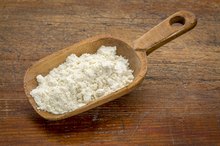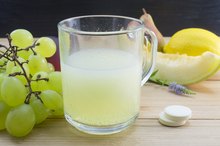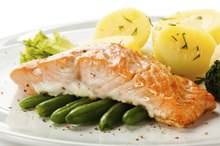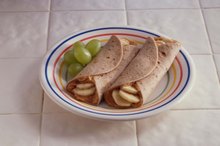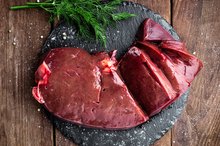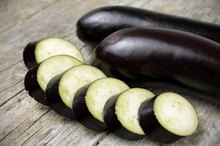What does fact checked mean?
At Healthfully, we strive to deliver objective content that is accurate and up-to-date. Our team periodically reviews articles in order to ensure content quality. The sources cited below consist of evidence from peer-reviewed journals, prominent medical organizations, academic associations, and government data.
- Medline Plus; Uric Acid -- Blood; David C. Dugdale and David Zieve; May 2009
- "The New England Journal of Medicine"; Purine-Rich Foods, Dairy and Protein Intake, and the Risk of Gout in Men; H.K. Choi, et al.; March 2004
- "The New England Journal of Medicine"; Purine-Rich Foods, Dairy and Protein Intake, and the Risk of Gout in Men; H.K. Choi, et al.; March 2004
The information contained on this site is for informational purposes only, and should not be used as a substitute for the advice of a professional health care provider. Please check with the appropriate physician regarding health questions and concerns. Although we strive to deliver accurate and up-to-date information, no guarantee to that effect is made.
Gout and Sardines
Gout is a chronic inflammatory condition characterized by severe attacks of pain, redness and tenderness in the joints, especially the joint at the base of the big toe. At times, the joint can feel like it's on fire. Men are the most likely to suffer from gout, but women are also at high risk after menopause. Gout is caused by the excessive breakdown of purines from foods such as sardines.
If you are experiencing serious medical symptoms, seek emergency treatment immediately.
Cause
Purines are a class of chemical molecules that play a critical role as the building blocks of genetic material like DNA and RNA. When the purines reach the end of their life cycle, the liver converts them into a waste product known as uric acid. Some uric acid dissolves in the blood and passes out as urine, but high levels can form needle-like crystals in the joints. This is the provenance of the pain and inflammation endemic to gout.
- Purines are a class of chemical molecules that play a critical role as the building blocks of genetic material like DNA and RNA.
- When the purines reach the end of their life cycle, the liver converts them into a waste product known as uric acid.
Purine Concentrations
Gout and Shrimp
Learn More
Small oily fish such as sardines, herring and anchovies contain particularly high concentrations of purines. These concentrations are only rivaled by yeast, liver and certain kinds of meat. However, the precise amount of purines is not fixed. It can change, depending upon how the manufacturer prepares the sardines. Between 100 and 1,000 mg of purine per 3 oz. serving is a typical amount in sardines. By comparison, a normal daily intake is 600 to 1,000 mg.
- Small oily fish such as sardines, herring and anchovies contain particularly high concentrations of purines.
- serving is a typical amount in sardines.
Research
There is a general correlation between the amount of purines in the diet and the risk for gout, but the type of food also matters. In 2004, a group of researchers from Massachusetts General Hospital, publishing in "The New England Journal of Medicine," found that male subjects who ate seafood were at the highest risk for gout, whereas the moderate consumption of purine-rich vegetables did not increase risk and dairy products actually decreased it 2. The study should not be mistaken for medical or dietary advice, but vegetables and dairy are part of a healthy diet and may work to counteract the effects of gout.
Fish Oil
Foods That May Cause Joint Pain
Learn More
If you are not getting enough omega-3 fatty acids in your diet, your doctor may advise you to take fish oil, a dietary supplement derived from oily fish such as sardines. Fish oil is distilled and highly purified and contains very little if any of the purines typically found in fish, so it should not affect your risk for gout. The opposite is also true. If you are at risk for gout, then you may want to take fish oil supplements as a way to achieve the daily recommended intake of omega-3 fatty acids without consuming fish.
- If you are not getting enough omega-3 fatty acids in your diet, your doctor may advise you to take fish oil, a dietary supplement derived from oily fish such as sardines.
- If you are at risk for gout, then you may want to take fish oil supplements as a way to achieve the daily recommended intake of omega-3 fatty acids without consuming fish.
Related Articles
References
- Medline Plus; Uric Acid -- Blood; David C. Dugdale and David Zieve; May 2009
- "The New England Journal of Medicine"; Purine-Rich Foods, Dairy and Protein Intake, and the Risk of Gout in Men; H.K. Choi, et al.; March 2004
- "Arthritis Today"; Safety of Fish Oil Supplements with Gout; James McKoy
- National Institute of Arthritis and Musculoskeletal and Skin Diseases. Gout. Updated April 2016.
- Zhang Y, Chen C, Choi H, et al. Purine-rich foods intake and recurrent gout attacks. Ann Rheum Dis. 2012; 71(9):1448-53. doi:10.1136/annrheumdis-2011-201215
- Fischer E. Ueber die Harnsauer. 1 [On Uric Acid. 1]. Berichte der Deutschen Chemischen Gesellschaft. 1884: 17:328-338. doi:10.1002/cber.18980310304
- Ragab, G., Elshahaly, M., & Bardin, T. (2017). Gout: An old disease in new perspective – A review. Journal of Advanced Research, 8(5), 495–511. doi:10.1016/j.jare.2017.04.008
- Centers for Disease Control and Prevention. Gout. Updated January 28, 2019.
- Zgaga, L., Theodoratou, E., Kyle, J., Farrington, S. M., Agakov, F., Tenesa, A., … Campbell, H. (2012). The Association of Dietary Intake of Purine-Rich Vegetables, Sugar-Sweetened Beverages and Dairy with Plasma Urate, in a Cross-Sectional Study. PLoS ONE, 7(6), e38123. doi:10.1371/journal.pone.0038123
- Choi HK, Gao X, Curhan G. Vitamin C intake and the risk of gout in men: a prospective study. Arch Intern Med. 2009;169(5):502–507. doi:10.1001/archinternmed.2008.606
- Zhang Y, Neogi T, Chen C, Chaisson C, Hunter DJ, Choi HK. Cherry consumption and decreased risk of recurrent gout attacks. Arthritis Rheum. 2012;64(12):4004–4011. doi:10.1002/art.34677
- Arthritis Foundation. Gout Diet: Dos and Don’ts.
- Boban M, Modun D. Uric acid and antioxidant effects of wine. Croat Med J. 2010;51(1):16–22. doi:10.3325/cmj.2010.51.16
- Caliceti C, Calabria D, Roda A, Cicero AFG. Fructose Intake, Serum Uric Acid, and Cardiometabolic Disorders: A Critical Review. Nutrients. 2017;9(4):395. Published 2017 Apr 18. doi:10.3390/nu9040395
- U.S. Department of Health and Human Services and U.S. Department of Agriculture. 2015–2020 Dietary Guidelines for Americans. 8th Edition. Published December 2015.
- U.S. Department of Health and Human Services. Gripped by Gout. NIH News in Health. Published February 2014.
- Kakutani-Hatayama M, Kadoya M, Okazaki H, et al. Nonpharmacological Management of Gout and Hyperuricemia: Hints for Better Lifestyle. Am J Lifestyle Med. 2015;11(4):321–329. Published 2015 Sep 2. doi:10.1177/1559827615601973


